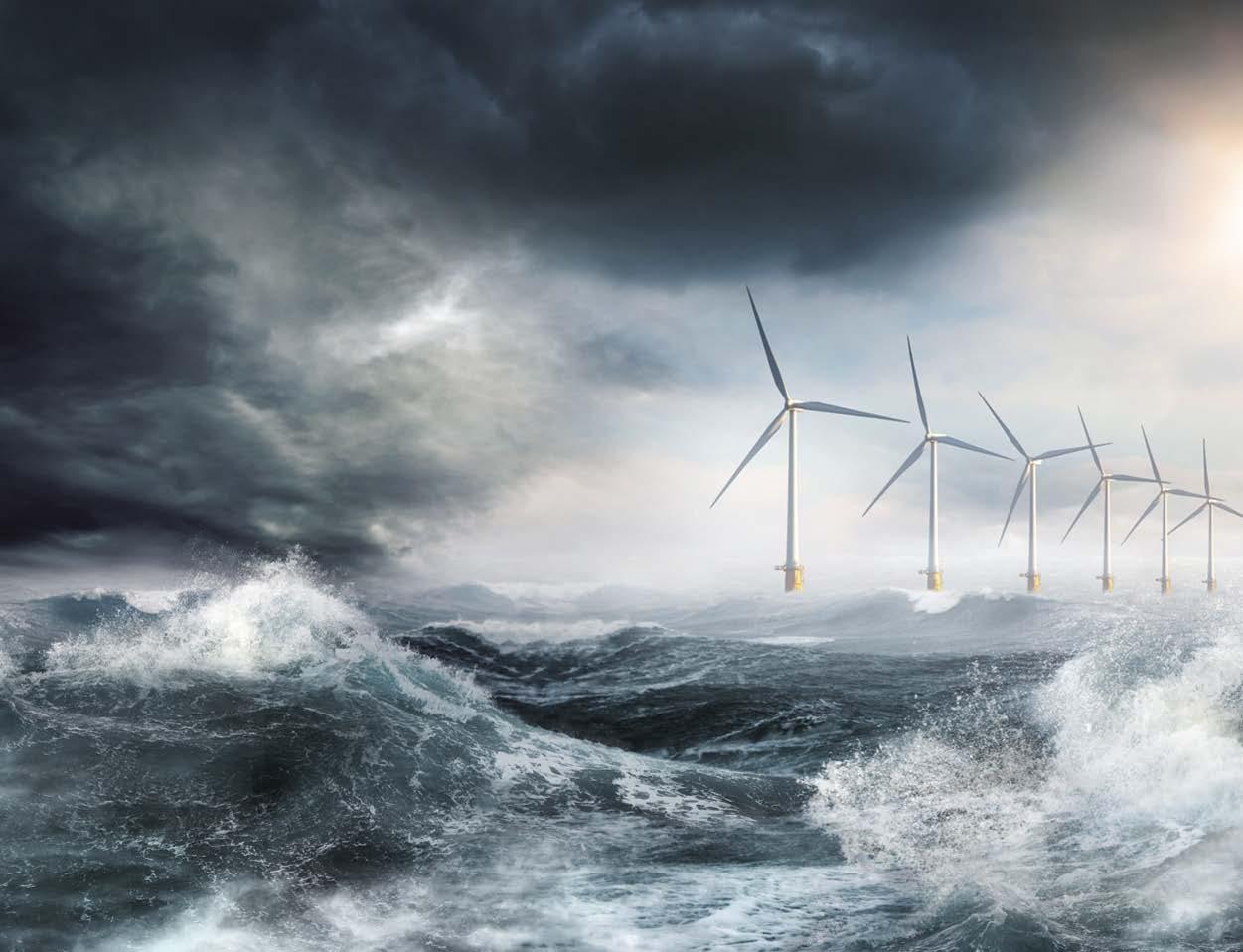
4 minute read
GLASS FLAKE COATINGS COULD MEAN END TO OFFSHORE WIND SUBSTRUCTURE SURFACE MAINTENANCE
by Ismail Tan, Jotun A/S - Sandefjord, Norway
Glass flake polyester (GFP) coatings offer more than 30 years’ maintenance-free corrosion protection at the splash zone for offshore assets, according to a new independent report from classification society DNV.
The study shows that Baltoflake, a GFP solution developed by leading coatings manufacturer Jotun, provides decades of protection for offshore wind substructures and reduces lifecycle costs by up to 50%.
The high-performance coating is ideal for deployment in the offshore wind sector, where strong corrosion resistance and excellent mechanical properties are required.
DNV inspected a section of jacket from a North Sea oil platform which was installed in 1972 and decommissioned in 2020. Jotun’s Baltoflake coating was applied to the platform in the late 1980s and, despite over 30 years’ exposure to the North Sea’s harsh environment, analysis revealed that the coating at the splash zone was intact, still smooth and showing no signs of delamination. Ismail Tan, Global Category Manager - new construction primers, at Jotun said: “Although glass flake coatings have been used in the energy industry for over 40 years, there has traditionally been very little research into the material’s long-term benefits. However, by partnering with DNV on this report, we now have the relevant in-field data required to demonstrate Baltoflake’s full asset lifecycle protection performance. Baltoflake removes the requirement for offshore wind developers to undertake expensive repairs or replacement due to corrosion. By reducing overall maintenance costs and downtime, we can empower operators to focus their efforts on clean energy generation.”
DNV is an independent assurance and risk management provider, operating in more than 100 countries, with the purpose of safeguarding life, property, and the environment. As a trusted voice for many of the world’s most successful organizations, it helps seize opportunities and tackle the risks arising from global transformations. The company uses its broad experience and deep expertise to advance safety and sustainable performance, set industry standards, and inspire and invent solutions.
According to recent figures1, global installed offshore wind capacity is expected to reach 630 gigawatts (GW) by 2050, up from 40 GW in 2020. However, with global steel stocks and production declining following the pandemic, and with the war in Ukraine locking out around 10% of the global steel trade2, the cost of steel is skyrocketing while availability drops, putting pressure on offshore wind projects.
Offshore wind developers are at an increased risk of rising prices due to the large turbine sizes, longer foundation structures and substation requirements. However, with offshore turbines designed to last for 20-25 years, solutions like Baltoflake have the potential to extend the life of new and existing turbines by more than 10 years, reducing lifecycle costs by 50% in the process. Introduced during the 1970s, Baltoflake was one of the first performance coating products targeted for offshore environment deployment. The coating has glass flake materials incorporated into polyester to create structure that is 5–20 times more impermeable than resin alone.
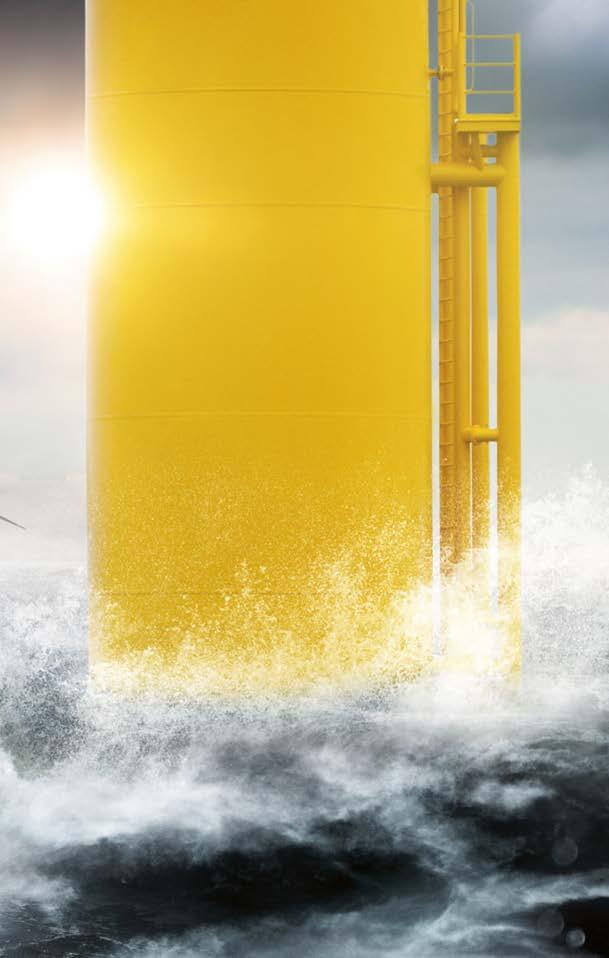
Glass flake coatings have an outstanding corrosion resistance to a wide range of acids, alkalis, solvents and salt solutions, whilst displaying excellent thermal stability.
With decades of experience protecting assets in the harshest environments, Jotun, headquartered in Sandefjord, Norway, is a world leader in coatings for offshore structures. The company has developed high performance coatings for the offshore industry for more than 50 years.
The report was launched last year at ONS exhibition in Stavanger (Norway). ‹
1 https://www.mckinsey.com/industries/electric-power-and-natural-gas/our-insights/how-to-succeed-in-the-expanding-global-offshore-wind-market
2 Ukraine war causes global steel shortage (etmm-online.com)
High-performance composite repair solution for offshore risers reinforcement

edited by 3X Engineering, Monaco lc@3xeng.com
3X was commissioned to perform a repair work of 19 risers of an offshore Oil&Gas structure in Qatar. In order to protect the risers in their splash zone was chosen the 3X composite solution REINFORCEKiT® 4D.
3X ENGINEERING (3X) is one of the world leading companies specialized in pipeline maintenance using composite technology. In October 2022, 3X ENGINEERING performed a repair work in order to protect (mechanical protection + impact resistance) 19 risers (from 8” to 20” OD) on their splash zones and thus prevent further deterioration of the risers. To do that, it was decided to protect the risers areas using 3X composite solution REINFORCEKiT® 4D.
The main R4D’s features REINFORCEKiT® 4D (R4D) is a wet layup system, wrapped helicoidally around the pipe in order to bring the mechanical resistance to the damaged pipe section. The number of layers, determined by calculation, is linked not only to the pipe pressure, temperature, diametre and thickness but also to the pit depth and length, the steel grade and the pipe location. The repair design and material requirements are provided by 3X software REA after information compilation according to ASME B31G, ISO 24.817 and ASME PCC-2 codes and standards.

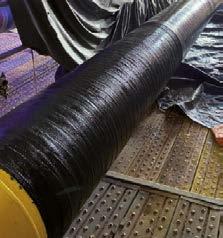
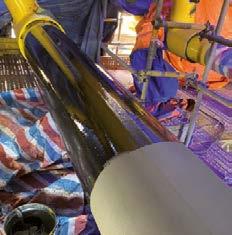

REINFORCEKiT® 4D is recommended to repair and reinforce pipelines operating at temperature between -50°C (-58°F) up to +150°C (+302°F) subject to external/ internal corrosion, leaks (dedicated procedure for live repair), dents and mechanical damages. The system restores the pipe integrity and prevents from further deterioration. This composite sleeve is made of 400 g/m² Kevlar® tape and highly-reinforced ceramic epoxy resin.
Qatar case study: scope of work
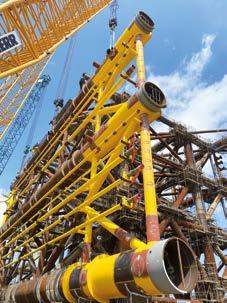
According to ISO 24.817 standard and 3X calculations, it was decided to apply
6 layers of REINFORCEKiT® 4D (using R3X95 resin) on each riser to protect them from impacts and corrosion issues. Surface preparations were completed using sandblasting to remove coating and create a good surface roughness (superior to 60μm Rz) and ensure a good bonding between the steel pipes and the composite solution. Then hygrometric conditions were checked and the whole prepared surfaces were cleaned with air blower.
The composite applications were then completed following the main stages mentioned below (the procedure was the same for the 19 risers):
1 - One layer of R3X95 resin was firstly applied on the prepared surface to ensure the good impregnation of the first tape layer.
2 - Composite wrapping was then completed using Kevlar® tape impregnated with R3X95 resin. Six layers were applied on each riser with a repair length between 7220mm and 9200mm. A total of over 175m repair length using REINFORCEKiT® 4D product was installed on the 19 risers.
3 - Last layer of R3X95 resin was applied all over the wrappings as finalization stage and id plate was installed for traceability.
4 - Eight hours after, coating was applied on the composite protection.
Results
Samples of resin were taken during each tape impregnation for quality control and hardness measurements were performed and validated on site and in 3X offices. The 19 risers are now protected with REINFORCEKiT® 4D from impacts and corrosion issues that could affect their mechanical resistance. The design life for each riser for this composite protection is 20 years. ‹
The Work At A Glance
Defect types details: Mechanical protection - 19 risers. From 8" to 20" gas risers, straight line, max. operating temp. 70 °C, calculated pressure 60 bars.
Location: Qatar, offshore.
3X solution: REINFORCEKiT® 4D.










